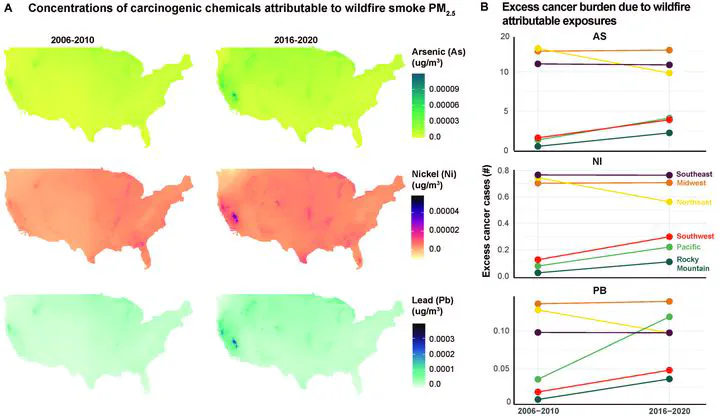The influence of wildfire smoke on ambient chemical species concentrations in the contiguous US
Aug 14, 2024· ,,,,,,,,,,·
0 min read
,,,,,,,,,,·
0 min read
Emma Krasovich Southworth
Minghao Qiu
Carlos Gould
Ayako Kawano
Jeff Wen
Sam Heft-Neal
Kara Kilpatrick Voss
Alandra Lopez
Scott Fendorf
Jennifer Burney
Marshall Burke

Abstract
Wildfires are a significant contributor to ambient air pollution and pose a growing public health threat in many parts of the world. Increased wildfire activity over the past few decades has exacerbated smoke exposure across the US, yet our understanding of how wildfire influences specific chemicals and their resulting concentration in smoke remains incomplete. We combine 15 years of daily measures of species-specific PM2.5 concentrations from 700 air pollution monitors with satellite-derived estimates of ambient wildfire smoke PM2.5, and use panel regression to estimate the contribution of wildfire smoke to the concentrations of 27 different chemical species in PM2.5. We find that wildfire smoke drives detectable increases in the concentration of 25 of the 27 species, with the largest increases observed for chemicals previously associated with biomass burning: organic carbon, elemental carbon, and potassium. We find that smoke originating from wildfires that burned structures had higher concentrations of copper, lead, zinc and nickel relative to smoke from fires that did not burn structures. Wildfire smoke is responsible for an increasing share of ambient species concentrations for multiple species, especially in the Western US. Using existing estimated relationships between ambient chemical exposure and cancer risk, we find that wildfire enhancement of carcinogenic species concentrations could be enough to cause small increases in cancer risk, but these increases are very small relative to other risk factors. Our results demonstrate that fixed ground monitors in combination with satellite-derived data can be used to understand how wildfire smoke influences chemical concentrations at large scales and measure population-level exposures.
Type